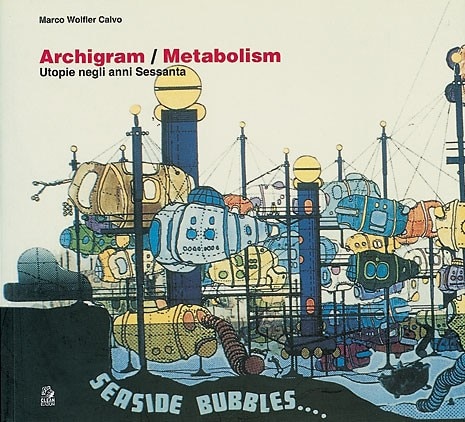Archigram/Metabolism. Utopie negli anni Sessanta
Marco Wolfler Calvo Clean, Napoli 2008 (pp. 132, € 15,00)
It is difficult to rein in the projects of Archigram and Metabolism within the pages of a book. This is because they are represented by posters and manifestos, which by definition are affixed to walls, exhibited at rallies, pasted up in university halls during student sit-ins, or trampled on the pavement, maybe after a furious protest. As the subtitle of Marco Wolfler Calvo’s book states, we are talking about the utopias of the ’70s, visions and projections of an architecture made of ideals and precise intellectual stances. In this sense, the book provokes a critical interpretation that describes a cultural journey towards and away from this period, which despite being perhaps shortlived nonetheless exerted a great influence that can still be felt today. It is not about understanding the radical utopias as an explosive phenomenon disconnected from all other references, but rather about using every clue to identify the fil rouge that ran through the entire 20th century, from the industrial revolution, through the world wars, to the ideological revolutions and the violent logic of the global economy.
Following this route, it is no coincidence that the first pages are dedicated to Sant’Elia and Buckminster Fuller. The former teaches us that “houses will not last as long as we do” and that “every generation will have to build its city”; and from the latter we are shown the possibility of a ten-storey apartment building being transported, simply and heroically, by a zeppelin floating among the clouds. Also starring here is the great Cedric Price, who interpreted architecture as being disconnected from concepts of monumentalism and immobility, creating his projects as places of crossing and transformation. The Japanese architect Kenzo Tange, with his young disciple Arata Isozaki, fed the consciousness of a technological architecture that could prevent the anxiety caused by demographic growth. The master and student would not be among the signers of the Metabolist manifesto. But Kiyonori Kikutake, the designer of Marine City, in some way legitimised the sharing of this idea when talking about the negation of function and static form to the advantage of variable, metabolic space. At the same time in England, the Archigram group was taking shape. The name is an ingenious neologism formed from the terms Archi-tecture and tele-gram: architecture that is rapid, mobile and instantaneous like a telegram, which at the time was roughly equivalent to modern-day email.
The cultural and temporal similarities between the English and the Japanese groups are evident, while the differences are mostly in the language and publicity. Archigram was the title of the first issue of a magazine that combined graphics, comic strips, art and architecture in a very pop mixture, predating any multi- or interdisciplinary magazine. Metabolism’s approach, on the other hand, was more low-key, though still utopian: less media and more pragmatism, attempting to give responses instead of suggestions. In any case, utopian fantasies took root everywhere, reinforcing the significance and value that existed in the panorama of world architecture.
Superstudio and Archizoom were the Italian emulators that influenced aspects closer to design. One need only think of the Monumento continuo, a project by Superstudio that, from the protagonist of marvellous photomontages depicted in every corner of the world, was reduced to the size of a small chequered table for the window of a Zanotta showroom or a middle- class lounge. Metabolism and Archigram instead moved towards a deeper understanding. This is proved by the projects themselves, which ambiguously became both response and request, continually postponing the end an extremely complex debate between modernism and tradition. Avant-gardes and utopias overlap in design proposals that we enthusiastically recognise as being progenitors of very current themes. Think of Kikutake’s cellular housing concept, of Cook’s plug-in city, or of Herron’s walking city, whose architectural, artistic, graphic and cinematographic influences are constantly there to see. In that sense, one can think of the Archigram and Metabolism period as a kind of baton passed between the possible future fantasised about in 20th-century postindustrial culture, and the futuristic, embodied by the technological conquests of the 21st century. In between lie social and economic transformations, which are as always unpredictable. In fact, mistakes were made that brought about the extinction of a radical and social architecture, made of infinitely repeatable mathematical modules, and of structures that are transportable and renewable everywhere. These were huge megastructures for people who are simply complex and unique in their housing requirements. And this certainly can-not be bridled.
Massimiliano Di Bartolomeo Architect


